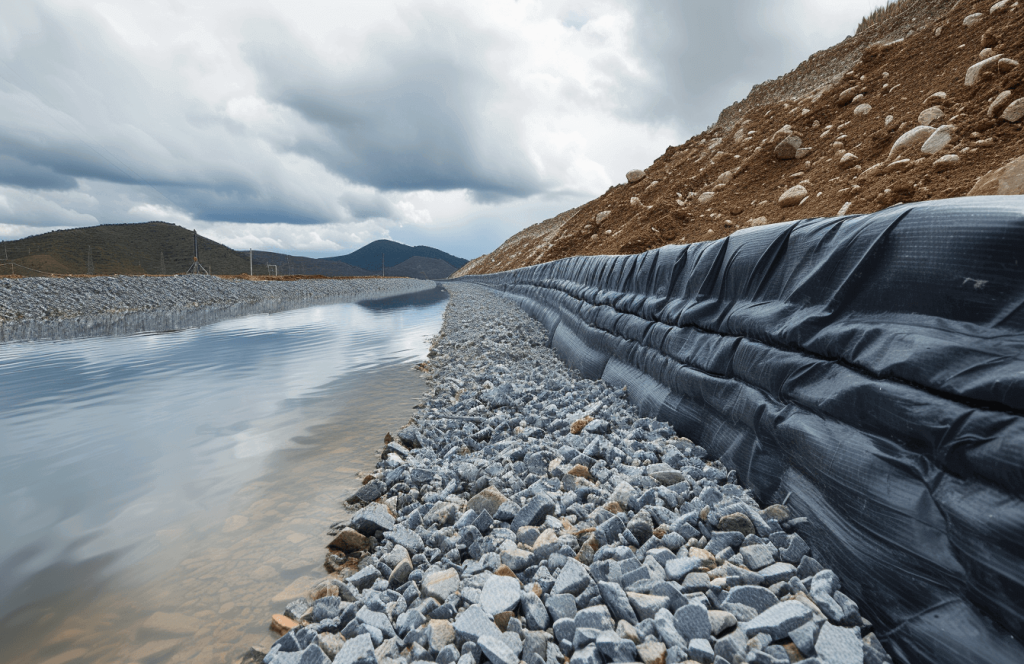
Natural disasters such as floods, landslides, and earthquakes pose significant threats to communities worldwide. In regions susceptible to these calamities, the importance of proactive measures for disaster mitigation cannot be overstated. Among the many technologies and tools available for such purposes, geosynthetics is a versatile and effective solution.
Geosynthetics, including geotextiles, geogrids, and geosynthetic clay liners, offer innovative approaches to bolstering infrastructure resilience and safeguarding lives and property against the destruction of nature.
Floods, characterized by the inundation of dry land by excess water, pose significant challenges to riverine communities. Geosynthetics offer excellent support in flood protection infrastructure, from reinforcing riverbanks to fortifying embankments and controlling surface erosion. Geotextiles and geomembranes act as barriers against water seepage, ensuring the structural integrity of dikes and dams.
Additionally, innovative applications like geotextile tubes provide flexible and efficient solutions for temporary flood mitigation, safeguarding vulnerable areas during periods of heightened risk.
In flood-prone regions, the timely deployment of geosynthetic flood barriers can mitigate the impact of inundation events, minimizing property damage and loss of life. By integrating geosynthetic materials into flood management strategies, communities can enhance their resilience to extreme weather events and ensure the continuity of necessary services.
Moreover, the cost-effectiveness and ease of installation associated with geosynthetic solutions make them a practical choice for communities seeking sustainable flood protection measures.
Landslides, prompted by both natural occurrences and human activities, pose a threat to both landscapes and communities. Geosynthetics play an important role in landslide prevention by stabilizing slopes, enhancing soil cohesion, and facilitating drainage.
Geogrids and geotextiles, engineered for optimal tensile strength and permeability, reinforce embankments and retaining walls, mitigating the risk of mass soil movement. Moreover, geosynthetic-clad structures offer cost-effective alternatives to traditional methods, ensuring the long-term stability of terrain susceptible to landslides.
The effectiveness of geosynthetic solutions in landslide mitigation is further enhanced by their compatibility with existing soil conditions and terrain characteristics. Communities can mitigate the risks posed by landslides and protect lives and livelihoods by leveraging geosynthetics to reinforce critical infrastructure and stabilize vulnerable slopes.
Additionally, the versatility and adaptability of geosynthetic materials make them invaluable tools in landslide-prone regions, where traditional engineering solutions may be impractical or prohibitively expensive.
The stability of slopes and retaining walls is highly important in disaster-prone regions, where terrain vulnerability exacerbates the risk of structural failure. Geosynthetic reinforcements, comprising geogrids and geotextiles, bolster earthworks and infrastructure, minimizing the impact of seismic events and erosion. Through innovative design approaches, such as geogrid-reinforced earth structures, engineers can optimize space utilization and construction efficiency while ensuring structural resilience. Geosynthetics allow communities to mitigate the consequences of earthquakes and landslides, which boosts safer environments for habitation and development.
The integration of geosynthetic reinforcements into slope stabilization and retaining wall construction projects offers numerous advantages, including enhanced structural integrity, reduced material requirements, and accelerated construction timelines. Engineers can overcome the challenges by challenging terrain conditions and geological hazards by harnessing the inherent strength and durability of geosynthetic materials.
Moreover, the scalability and versatility of geosynthetic solutions enable communities to adapt to evolving environmental conditions and mitigate the risks associated with natural disasters.
Coastal erosion, a consequence of natural processes compounded by human activities, jeopardizes settlements and infrastructure along coastlines globally. Traditional methods of erosion control, such as dikes and breakwaters, are evolving to incorporate geosynthetics for enhanced effectiveness and sustainability.
Geotextile containers, woven from durable synthetic fibers, serve as protective barriers against erosive forces while promoting marine biodiversity. Moreover, geosynthetic solutions align with environmental conservation efforts, mitigating the adverse impacts of coastal development.
Coastal communities face an escalating threat from rising sea levels and increasingly severe storm surges. Geosynthetics offer a dynamic approach to shoreline protection, capable of adapting to evolving coastal dynamics. By employing innovative techniques such as geotextile tubes and artificial reefs, engineers can fortify vulnerable coastlines while preserving ecological balance.
Geosynthetic solutions not only mitigate the immediate risks of coastal erosion but also boost long-term resilience in the face of climate change-induced sea-level rise.
In overcoming the many challenges brought by natural disasters, geosynthetics is an indispensable tool for disaster mitigation and infrastructure resilience. Across diverse applications, from earthquake to landslide prevention, these innovative materials offer cost-effective, sustainable solutions. As climate change intensifies the frequency and severity of extreme weather events, the role of geosynthetics in disaster preparedness and response becomes increasingly important.
By adopting geosynthetic technologies, communities can strengthen their defenses against floods, landslides, earthquakes, and more, which in turn, ensures a safer and more sustainable future for generations to come.
In summary, using advanced materials like geosynthetics in disaster prevention strategy presents a big change in engineering. It is a way of using innovative ideas to overcome the challenges brought by nature.
With climate change causing more and more issues worldwide, investing in geosynthetic infrastructure is becoming more important. Geosynthetics is versatile and effective, helping communities overcome uncertain environmental challenges and building a more resilient future.
Copyright © Gateway Structure Sdn Bhd (199401025111). All Right Reserved.